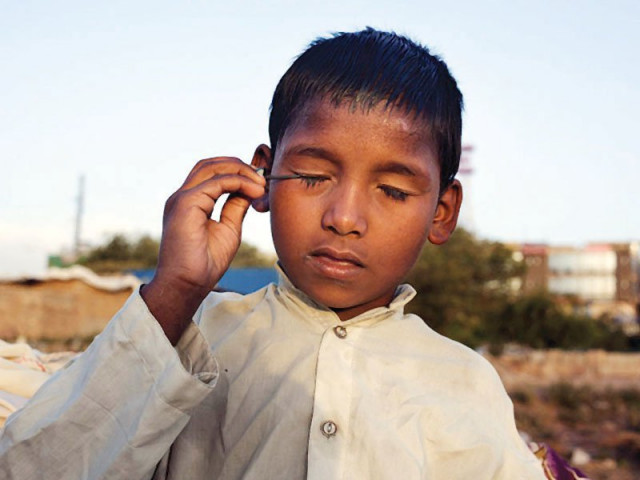Surma: Can’t you see how bad it is?
Lead absorbed from surma in a child’s eyes can lead to retarded growth.

Lead absorbed from surma in a child’s eyes can lead to retarded growth. PHOTO MYRA IQBAL
Many people think surma or kohl is made of one of antimony’s minerals, stibnite, that was used in Egyptian cosmetics four or five thousand years ago as black eyeliner. But the truth today is that commercially produced surma has less antimony and more Lead Sulphide. This dangerous chemical is a known developmental neurotoxicant, which has even come to the notice of the US Food and Drug Administration. In fact surma products are banned in North America.
But paediatrician Assistant Prof Dr Mohsina Noor Ibrahim sees far too many children with kohl-rimmed eyes at Karachi’s National Institute of Child Health. What angers her most is the use of surma on wounds. “Parents should never apply surma to a newborn’s umbilical cord, as it can lead to infection, such as tetanus,” she warns.
“Surma’s quality, especially its composition, is a mystery. We don’t know what colour particles they are using and what is the metal content of surma.”
Given that the government does not regulate how these cosmetics are made, it is not clear what goes in them. But several studies, some from as far as Israel and Bahrain, have found that kohl manufactured in the Middle East and the Indian subcontinent has had up to 79% lead. Other metals included iron, carbon, aluminum, camphor and menthol.

These elements are absorbed in the blood through the nasolacrimal duct, which connects the eyes to the nose, and esophagus eventually leading to the stomach, explains Dr Tayyaba Batool, a consultant paediatric surgeon at Ziauddin University Hospital.
The best way to tell your blood lead levels is to get a blood test. For adults there should be no more than 20 micrograms per decilitre of lead in the blood and for children 10. Your doctor can use test results to tell if there is a case of lead poisoning, whose common symptoms are anemia, growth retardation and kidney problems.
And it’s not just the surma that can cause problems. Surma applicators are made of metal or wood, which when unclean can cause fungal and bacterial infections in the eye. Ophthalmologist Dr Jamal Mughal with Karachi’s Akhtar Eye Hospital also warns that if parents use force to apply the kohl they can injure them too.
Aside from cultural tradition, people believe it is Sunnat to use surma, it improves eyesight and cures. But a hakim, Syed Muhammad Rehan Alam, warned that the commercial brands produced today are nowhere near the quality of surma used centuries ago. “[They] use colour in surma [but] the formula that was used by hakims is a difficult procedure,” he said.
Experts at the King Khaled Eye Specialist Hospital and several other institutes in Riyadh did report the interesting finding that some kohl preparations had a weak antimicrobial effect against Streptococcus, Staphylococcus and Proteus species. But they still discouraged use of lead-based kohls.
The discovery of lead content in this cosmetic has been a cause of concern for a while. Researchers have even studied how a baby’s blood lead levels can go up through the umbilical cord if the mother applies surma.
Doctors can only fight cultural beliefs so much. Abdullah’s six-month son Qasim has been admitted to the NICH. His wife told him to bring some surma from home because she felt his eyes looked “empty and small” without it. “I don’t know why Qasim has vision problems even after we use surma,” he said.
Published in The Express Tribune, Sunday Magazine, September 8th, 2013.



















COMMENTS
Comments are moderated and generally will be posted if they are on-topic and not abusive.
For more information, please see our Comments FAQ